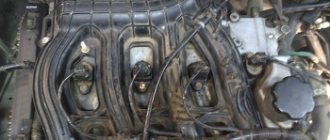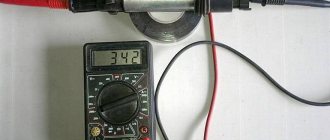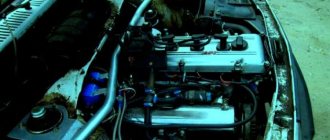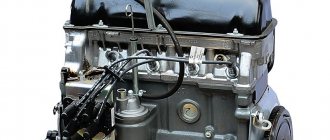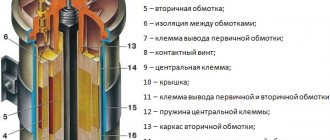The ignition coil on a VAZ 2107 car is used to convert a low voltage current of 12V into a high voltage current of 11-20kV, which is necessary to break down the air gap between the electrodes of the spark plug and form a spark that ignites the working mixture. On a VAZ 2107 car with a contact ignition system, an ignition coil of type B-117 A is used. The ignition coil is installed in the engine compartment of a VAZ 2107 car and is secured with nuts on two studs to the left mudguard. The ignition coil is a transformer with a magnetic core, consisting of a core and an outer magnetic circuit, and two windings - primary and secondary. The ignition coil core is made of electrical steel plates and is located in a frame on which the secondary winding is wound. The primary winding is wound through the insulator on top of the secondary winding. The outer magnetic circuit consists of a rolled strip of electrical steel. The ignition coil housing is made of steel, the ignition coil housing has a cylindrical shape. On top, the ignition coil housing is hermetically sealed with a cover made of insulating material. To improve cooling and insulation, transformer oil is poured into the ignition coil housing. The ignition coil cover has a high-voltage and two low-voltage terminals. The high-voltage output is connected to the secondary winding and, through a contact bolt and spring, to the core. The end of the primary winding is connected to one low-voltage terminal of the ignition coil, connected by a wire to the contact group of the ignition distributor. Voltage from the ignition switch is supplied to the “+B” terminal of the ignition coil.
On a VAZ 2107 car with a contactless ignition system, ignition coils of type 27.3705 (with an open magnetic circuit, oil-filled) or type 3122.3705 (with a closed magnetic circuit, dry) are used.
Checking the ignition coil of a VAZ 2107 car
To perform work on checking the ignition coil on a VAZ 2107 car, you will need a multimeter.
For clarity, we carry out the test on a removed ignition coil.
1. Disconnect the wires from the ignition coil terminals (see “Removing the ignition coil”).
2. Clean the ignition coil from dirt and rinse it with white spirit or kerosene.
3. Connect the ohmmeter probes to the terminals of the primary winding of the ignition coil and measure the resistance. The resistance of the primary winding of the B-117 A ignition coil at a temperature of 20″C should be 3-3.5 Ohms (for an ignition coil type 27.3705 - 0.45-0.5 Ohms).
4. Having connected the ohmmeter probes to the high-voltage and the “+B” terminal of the ignition coil, we measure the resistance of the secondary winding. The resistance of the secondary winding of the B-117 A ignition coil at a temperature of 20″C should be 7.4-9.2 kOhm (for a coil type 27.3705 - 5-0.5 kOhm).
Removing the ignition coil from a VAZ 2107 car
2. On a VAZ 2107 car, disconnect the wire from the negative terminal of the battery (see “Battery for a VAZ 2107 car - removal and installation”).
3. Disconnect the wire from the high-voltage terminal of the ignition coil.
4. Using an 8 mm wrench, unscrew the nuts on the ignition coil terminals and disconnect the wires. A red-blue wire is connected to the “+B” terminal of the ignition coil.
5. Using a 10 mm socket wrench, loosen, without unscrewing completely, the two nuts securing the ignition coil to the mudguard studs.
6. Sliding the ignition coil, remove the coil from the studs.
Installing an ignition coil on a VAZ 2107 car
Installing the ignition coil on a VAZ 2107 car is performed in the reverse order. In this case, the tip of the “mass” wire is installed between the ignition coil eye and the washer.
Diagnostics and replacement of the ignition coil
The type of coil used on the VAZ2107 is B-117A, it was specially designed for classic cars with a contact ignition system. This device consists of the following parts:
- core;
- external magnetic circuit;
- primary and secondary winding.
The core is a set of plates made of steel of special electrical grades. This part is the basis for coils isolated from each other. The coil has a metal body filled with transformer oil. The cover, made of dielectric, has two contacts for powering the primary coil and one terminal for the high-voltage wire.
Distributor diagnostics
Malfunctions of the ignition system can be caused by a breakdown of a component such as a distributor. Several types of problems may arise in it that can damage the contact ignition of the VAZ 2106. So, if the coil is working properly, then the problem in the operation of the system is due to the fact that the distributor, which has the contact ignition of the VAZ, has broken down.
To check, you need to remove the cover and inspect it. All contacts and contact angle must be free of damage and cracks. After inspecting the cover, you need to check the distributor slider. Sometimes cracks appear on this element as a result of wear, which leads to breakdowns to ground.
After inspecting the slider, the breaker contacts are examined, if necessary, they are cleaned, and the gap between them is checked. It is imperative to inspect the capacitor, since most often it is the one that is faulty, which is the reason for the failure of the vehicle systems. If there is no charge accumulation after applying voltage, the capacitor must be replaced.
When checking the ignition of the VAZ 2106, we must not forget about the spark plugs. The fact is that the normal operation of the system depends on the gap between the spark plug electrodes. The spark plug gap should be 0.4-0.8 mm. Increased play leads to heating of the coil and, as a result, possible breakdown of its windings.
The VAZ ignition relay is designed to protect the system from sudden changes in voltage at the moments of switching on and off. It protects the contacts of the lock and the breaker from burning, thereby ensuring the long service life of these components. The contacts in the VAZ ignition relay open almost instantly, which prevents the formation of sparks during operation.
The advantage that the VAZ ignition relay has over other elements of the system is the ease of its replacement in case of failure. When repairing a car, it is better to have a special manual on hand. As a rule, such a publication, in addition to a textual explanation, contains photographs of vehicle components, which facilitates repairs.
Often the reason for the disappearance of the spark on the spark plugs is a malfunction of the ignition coil (IC). The article describes the device, how to check the ignition coil of a VAZ 2106, its malfunctions and how to eliminate them.
Procedure for checking ignition system devices
The main reason for the failure of this device is a wire break in the primary or secondary winding. This ignition system device is checked using a multimeter set to resistance measurement mode. The operation can be performed either directly on the car or after it has been dismantled.
Open the hood of the VAZ2107 car and disconnect the battery. The coil installed on the mudguard in the engine compartment is disconnected from the on-board network and cleaned of contaminants. At the first stage, we check the resistance in the primary winding; its value should be in the range from 3.0 to 3.5 Ohms. We perform the same operation for the secondary winding, acceptable values are from 7.4 to 9.2 kOhm.
Checking the ignition module
Checking the ignition module for functionality is carried out in the following ways:
Replacing the ignition module with a known good one
1. The easiest way is to connect a known working module. In this case, the devices must be completely identical, the high-voltage wires are in good condition, and the reliability of the contacts has been checked.
Checking the contacts on the ignition module
2. Moving the module, which allows you to identify unreliable contacts. To do this, move the wire block and the module itself. If during exposure the engine reacts by changing its operation, then the cause of the problem lies in poor contact.
Measuring resistance at the terminals of the ignition module
3. Resistance measurement. To do this, you will need a tester switched to ohmmeter mode. Measurements are carried out on the paired terminals of the module between cylinders 1 and 4, as well as cylinders 2 and 3. The resistance value should be the same and approach 5.4 kOhm.
Checking the ignition module using a tester
4. Check the voltage with a tester. One probe of the device is applied to contact A of the block, the second to ground. After turning on the ignition, take readings from the device. If the wire is in good condition, it will show a voltage of 12 V; if it is missing, check the fuse protecting the ignition module. Then check the continuity of the circuit with a 12 V test lamp. Apply one end of the wire to contact A and rotate the starter. If the lamp does not blink, the circuit is broken. The procedure is repeated in a similar way with other contacts.
Diagnostics of the ignition module with professional equipment
5. Diagnostics at a service station by connecting a computer with special software to the computer. Malfunctions are detected in the form of errors indicated by an alphanumeric code, after which a more in-depth diagnosis of the malfunction is carried out to make a decision - repair the ignition module or replace it. A similar check is carried out at a specialized service station using an oscilloscope.
Replacing the device
If the indicators do not correspond to the above values, the ignition coil is considered faulty. Such a device must be replaced with a working one, which can be purchased at almost any spare parts store. When purchasing the device, you must inspect it and check the availability of documents: technical passport and certificate.
Removing the ignition coil on a VAZ2107 car is carried out with the battery disconnected. Use a wrench to unscrew the nuts on the contact and mounting studs. The faulty device is removed. A spare part is installed in its place and secured and connected. Now you can connect the battery and start the engine.
How to check the ignition coil of a VAZ 2106
How to check the ignition coil of a VAZ
2107 - 2101
carburetor coil in a car is not the least important ignition detail due to which the car may not work. To check the coil we will consider two options and with these two options everyone will find a convenient option for themselves. The first option will be considered how to check the coil on a VAZ with a multimeter the second option, as I said, will be simpler, but the efficiency is 70%: how to check the ignition of a VAZ 2107 - 2106 carburetor we will consider without a multimeter; the second option is probably the simplest, we will check it directly on the car, so let’s get started.
This is interesting: How to correctly respond to an inspector who demands to show documents
Egnition lock
Removing the "seven" lock
The ignition system on the domestic seven includes two main components - a coil and a module. The lock, in turn, consists of several parts - the switching mechanism itself, as well as the contact circuit. Each of these components is independent in its design, so if one of them breaks, it can be replaced without completely changing the lock. As for repairs, the VAZ 2107 ignition module can be repaired at home if you have all the necessary tools and an idea of how this procedure is performed.
On a carburetor or injector, the functionality of the lock can be determined using a special tester - a multimeter. To check contact ignition, the multimeter probes should be connected to the outputs on the lock one by one, and the output should correspond to one or another position of the key. If the contact group is operational, the multimeter will display a resistance that tends to zero. If the resulting indicator is different, this indicates the need to repair the contact group or replace it. In some cases, such parameters may be due to oxidation or burnt contacts, which can be corrected without replacing the group.
How to check the ignition of a VAZ 2106 with a multimeter
In order to check the coil with a multimeter, we need the multimeter itself and, of course, the ignition coil itself. take a multimeter and set it to 200-ohm, then check the terminals (B - K), the resistance should be at least in the range of 04.0-ohm, the resistance range is from 03.8 to 04.5-ohm, this is the norm; there’s clearly something wrong with the coil; now we need to check the high-voltage part; we set it measurement mode 20-klom 1 any probe on mark B or K another on the high-voltage contact resistance 7.6 klom 7 to 8 klom this is the norm This means your coil is intact, but also do not forget that there may be an internal breakdown of the coil, that is, a breakdown of the insulation between the high-voltage and low-voltage winding and also the interturn one, and you also need to check the case, that is, also at 20 kL, we leave the relative mass for each contact, we check because we came across coils, so we check everything is fine on the case, it breaks through, and if there are no short circuits between the winding and interturn circuits, then it will function.
How to check the ignition coil of a VAZ 2107 - 2106 carburetor
The second option is simpler: we pull out the high-voltage wire from the distributor that leads to the ignition coil, bring it to ground without touching about 0.5-0.9 millimeters and turn it with the starter, the spark should be saturated with a blue-yellowish tint and loud, if this is not the case, you can safely change your voltage loss (Make sure that the battery not discharged! How to check the VAZ generator ) also if there is a second ignition coil, you can simply throw wires on it and check to start the engine and see how it works or, as mentioned earlier, for a spark by weight how to install the ignition on a VAZ 2106 .
Briefly about ignition
To understand why there is a reel in a car (this is a popular name), and what part it takes in ensuring movement, you need to at least generally understand the structure of ignition systems.
A simplified diagram of how the reel works is shown below.
The positive terminal of the coil is connected to the positive terminal of the battery, and the other terminal is connected to the voltage distributor. This connection scheme is classic and is widely used on VAZ family cars. To complete the picture, it is necessary to make a number of clarifications:
- The voltage distributor is a kind of dispatcher that supplies voltage to the cylinder in which the compression phase has occurred and the gasoline vapors should ignite.
- The operation of the ignition coil is controlled by a voltage switch; its design can be mechanical or electronic (contactless).
Mechanical devices were used in old cars: the VAZ 2106 and the like, but now they are almost completely replaced by electronic ones.
A little theory.
On the “seven”, as a rule, contact ignition systems of the B-117 A type are used. The coil itself is located in the engine compartment and is attached to the left mudguard with two studs. Also found on the VAZ 2107 are non-contact ignition systems (BSZ), in this case, coils of type 27.3705 are used, oil-filled with an open magnetic circuit, as well as type 3122.3705 dry coils with a closed magnetic circuit.
Signs of a faulty ignition coil
If, after turning the key in the ignition switch, you hear that the starter is turning, but the engine does not start, then, as a rule, this may mean that the ignition coil is not working correctly or has failed. Although there are many reasons why the engine does not start when you try to start it: spark plugs, explosive wires, problems in the fuel system (pump, fuel filter, clogged line), and so on.
But if, after all, the reason is in the ignition coil, then this can be understood by the following symptoms:
- There is no spark at the spark plugs;
- There is no current on the BB wires;
- Visual defects (cracks and chips on the reel body);
- A burning smell under the hood, which leaves traces of melting of the ignition coil (the primary or secondary winding has burned out).
Checking the ignition system on a VAZ 2106 car
| WARNING The VAZ 2106 is equipped with a contact ignition system. A voltage of approximately 24,000 V is supplied to the high-voltage wires (as an option, a contactless high-energy ignition system can be installed on a VAZ 2106 car - a voltage of approximately 40,000 V). At low current levels, this voltage is not life-threatening, but can lead to electrical injury. Therefore, if you handle a high-voltage wire with the ignition on, use a thick rubber glove or, as a last resort, pliers with insulated handles. |
To check the ignition system on a VAZ 2106 car, you will need: slotted and Phillips screwdrivers, pliers with insulated handles and a tester or 12 V test lamp with two wires connected to it. You can also use a car portable lamp.
RECOMMENDATIONS Before checking the ignition system, place the gear shift lever in neutral and leave the parking brake on.
1. With the ignition off on the car, check the integrity and fit of the high-voltage wires in the ignition distributor cover, as well as the fit of the high-voltage wire in the ignition coil. 2. Check the wires going to the ignition coil and their connections. Also check the wire connecting the distributor and the ignition coil.
3. Turn on the ignition on the VAZ 2106 car. Check if current is supplied to the ignition system. Connect one wire of the tester or warning lamp to the “+B” terminal of the ignition coil, and the other to ground. If no current is supplied to the ignition system, then the fault is in the ignition switch or in the wiring from the switch to the ignition coil. In order to get to the nearest car service center, you can apply emergency power to the ignition system. To do this, connect the “+B” terminal of the ignition coil and the “+” terminal of the battery with an additional wire. Fasten the wires securely. Keep in mind that now, in order to turn off the engine, you will need to disconnect the additional wire from the “+” terminal of the battery.
WARNING If strong sparking is noticed when connecting to the “+” terminal of the battery, this method will have to be abandoned - most likely, the wiring is shorted to ground.
5. If there is no spark between the spark plug electrodes, remove the distributor cover. Check if there is a gap between the breaker contacts. To do this, use a special wrench to turn the engine crankshaft so that the top of the ignition distributor shaft cam is strictly opposite the textolite pad of the moving contact lever. The gap between the moving and fixed contacts of the breaker should be 0.35-0.4 mm.
NOTE When using an autotester, the closed state angle of the contacts (UCS) is measured, which should be 55°. The measurement is carried out with the engine running! An approximate value can be obtained by cranking the engine crankshaft with the starter.
6. If the gap (UZSK) does not meet the standard, adjust it and be sure to check the ignition timing.
How to check the ignition coil of a VAZ 2107?
Checking the ignition on a VAZ 2107 is performed using a multimeter or ohmmeter.
- It is necessary to disconnect the wires from the ignition coil terminals.
- And connect the multimeter electrodes to the terminals of the primary winding of the ignition coil.
- Check resistance. The resistance of the primary winding on a coil of type B-117 A, at a temperature of 20°C should be approximately 3-3.5 Ohms, for a coil of type 27.3705 - 0.45-0.5 Ohms.
- Connect a multimeter to the high-voltage terminal “+B” to measure the resistance on the secondary winding. The resistance of the secondary winding on a coil of type B-117 A at a temperature of 20°C should be 7.4-9.2 kOhm, for another type of coil - 27.3705 (normal resistance is considered to be 5-0.5 kOhm).
In this video you will learn in more detail how to check the ignition coil
Lost spark in carburetor seven
The search for a breakdown in the form of a lack of spark should begin directly with an inspection of the high-voltage cables, coil and distributor. The cause of the malfunction may be an armored wire whose contact has moved away from the distributor or spark plug. If the high-voltage wire is working properly, then you need to resort to checking for the presence of a spark in the spark plug.
To check the presence of a spark in the spark plug, you need to unscrew it from the cylinder and place it on the engine, connecting it to the armor wire. After this, one person should try to start the engine by turning the starter, and the second should observe the presence or absence of sparking. The presence or absence of a spark can indicate malfunctions:
- If a spark is present, this indicates a malfunction in the spark plugs, high-voltage wires or distributor distributor.
- The absence of a spark means that the breakdown has occurred in the switch, ignition coil or Hall sensor.
After such an easy test, you can understand in which direction to look for a breakdown. To identify a breakdown, you should check each part listed above.
We identify the reasons for the disappearance of the spark
If there is no spark on a carburetor VAZ 2107 with contactless ignition, then the cause of the breakdown can be identified independently by checking every part of the car’s ignition system. How to check each element of the ignition system, we will consider further:
- If the coil fails, to check it, you need to measure the resistance of the windings and insulation. To do this, you will need to use a multimeter, setting it to resistance measurement mode. Depending on what type of coils is used, the resistance value will differ. Initially, you need to set the multimeter to the 200 Ohm measurement mode, and touch the “+” and “K” contacts with the probes. The device should show a value ranging from 0.2 to 3 ohms. At the next stage, you need to turn the multimeter into the 20 kOhm resistance measurement mode. One probe touches the “K” contact, and the second one needs to touch the central terminal to which the high-voltage wire is connected. The resistance value that the device should show is 2-4 kOhm. If it is not possible to check the coil with a device, then you must use a known good one.
- If the switch is faulty, you will need an oscilloscope to check it. However, not everyone has such devices, so the easiest way to check is to install a known-good device. There is a simple test method by which you can determine whether this device is working properly. To check, the following manipulations are performed: disconnect the wire from the ignition coil that is from the switch, and then connect it to a 12V lamp. The second end from the lamp should be connected to the ignition coil terminal. After this, you need to try to start the engine. The lamp should blink. If it does not blink, the device is faulty.
- Hall sensor malfunction. Using a voltmeter, you need to check the serviceability of the sensor. To avoid removing the sensor, we check it in the following way - using pins, we pierce the insulation of the green and white-black wires with them. After this, touch the pins with the probes of the multimeter, setting the voltage measurement mode. The crankshaft rotates, and at the same time we monitor the readings of the device. The readings should drop to 0.4V and rise to 9-12V. Such readings mean that the sensor is working.
- If the low voltage circuit is broken, it is necessary to check the integrity of the supply wires for insulation damage. To determine the presence of a break in the supply wires, you need to use a multimeter in continuity mode.
How to replace the ignition coil on a VAZ 2107
In most cases, the coil is irreparable, that is, it is almost impossible to repair it, so if the ignition coil malfunctions, it will have to be replaced. Replacing the coil on a VAZ 2107 is quite simple; any novice car owner can handle this task.
To work you will need:
- Socket heads for “8” and “10”;
- New ignition coil.
The actual replacement process itself:
1. First of all, remove the “-” terminal from the battery.
2. Next, we remove the central explosive wire of the coil output; to do this, simply pull it up with a minimum of effort.
3. Using the “8” socket, unscrew the nuts securing the terminals of the wires connected to the coil contacts.
4. Next, remove the coil itself; to do this, unscrew the two nuts securing the coil.
5. Remove the ignition coil and put a new one in its place.
Further assembly is carried out in reverse order.
Current:
Thank you for your attention, see you again at VAZ Do-It-Yourself Repair.
Visual inspection of the IKZ
Remove the ignition coils from the engine using a 10mm or Torx E8 socket wrench (depending on the powertrain model). Carefully inspect the removed coils. There should be no cracks, damage to the rubber cap, melting or leakage of plastic. The spring located inside the coil must be in the correct position.
Purpose of the ignition coil on the VAZ 2107
The ignition coil is a key component of the machine, without which ignition of the air-fuel mixture in the combustion chambers is impossible.
The main device without which the VAZ 2107 will not start is the ignition coil
The standard voltage of the VAZ 2107 electrical network is 12 volts. The purpose of the ignition coil is to increase this tension to a level at which a spark will occur between the electrodes of the spark plugs, which will lead to ignition of the air-fuel mixture in the combustion chamber.
Ignition coil design
Almost all ignition coils on VAZ cars are conventional step-up transformers equipped with two windings - primary and secondary. Between them is a massive steel core. All this is placed in a metal case with insulation. The primary winding is made of copper wire coated with varnish insulation. The number of turns in it can vary from 130 to 150. It is this winding that is supplied with an initial voltage of 12 volts.
The design of the ignition coil on the VAZ 2107 cannot be called complex
The secondary winding is located on top of the primary. The number of turns in it can reach 25 thousand. The wire in the secondary winding is also copper, but its diameter is only 0.2 mm. The output voltage supplied to the spark plugs from the secondary winding reaches 35 thousand volts.
Types of ignition coils
Over the years, different types of ignition coils were installed on VAZ cars, which differed in design:
- common coil. One of the earliest devices that was installed on the very first G7s. Despite its venerable age, the coil is still installed on the VAZ 2107 today. The design of the device was described above: two copper windings on top of a steel core;
- individual reel. It is mainly installed on cars with electronic ignition systems. In these devices, the primary winding is also located inside the secondary, but individual coils are installed on all 4 VAZ 2107 spark plugs;
- twin coils. These devices are only used on vehicles with electronic ignition systems. These coils differ from all others in the presence of double wires, thanks to which the spark is supplied not to one, but to two combustion chambers at once.
Location and connection diagram
The ignition coil on VAZ 2107 cars is located under the hood, near the left mudguard. Attached with two long studs. A rubber cap with a high-voltage wire is connected to it.
The coil is connected according to the diagram below.
The connection diagram for the VAZ 2107 ignition coil is not particularly complicated
Ignition system without runner
Installation of a four-terminal ignition coil (ignition module) from fuel-injected cars to carburetor cars.
A simple device for those who are tired of changing distributor caps and sliders. The efficiency of using these coils in the ignition system is much higher than classic ones, due to the reduction of losses when transmitting high voltage to the spark plugs. In a pair of slider and distributor cap, 30% of the spark energy is lost; there is no such deficiency in this system. Feel the effect immediately, in the form of improved engine performance, especially noticeable at idle speed. This circuit is a small add-on to the standard switch from a contactless ignition system, which can be soldered and started in a couple of hours.
L497 is an ignition controller located in a standard switch, the lower hall is standard, I took the upper hall with a built-in magnet, screwed it to the distributor cover approximately in the middle between the terminals and soldered a wire onto the slider, it turned out to be a phase sensor, who is too lazy to do this, they can screw a standard one from the injector .
A signal inverter from the sensor is made on the KT6116; it can be replaced with any low-power PNP structure. IRFZ44 transistors are parallel switches; they can be replaced with any other field switches with an insulated gate and low channel resistance, so as not to be hung on a radiator. The BU941 is a powerful composite transistor with built-in voltage protection, operating on the ignition coil, which can be replaced with the domestic KT898 (be sure to ensure good heat dissipation). The CD4047 chip is included in this circuit as a reset trigger; it can be replaced with our 561 series, for example K561TM2 in the corresponding connection.
The circuit works like this: the signal from the standard hall sensor comes to the fifth leg of the L497 chip, is processed there and from the fourteenth leg goes to the IRFZ44 parallel switches, one of them is opened by the CD4047b chip and then to the base of the switching transistor. Leg 3 of the CD4047 chip receives a signal from the same sensor and switches the transistors with each spark. The second hall is needed so that when starting the engine, the spark hits the desired cylinder, the signal from it resets the trigger to its original state, and then only confirms the choice of cylinders (it will run without it, it will only start every other time).
I placed the device in a standard switch with hinged mounting, and screwed the key transistors to the radiator. For those who will use two two-terminal coils instead of one four-terminal one, take exactly the same ones. This modernization of the ignition system cost me the cost of the coil and high-voltage wires to it, the remaining parts cost about 150 rubles.
Author: S.V. Tikhomirov (Pukhov). E-Mail: zasosu2009 [dog] ya.ru
About the choice of ignition coils for the VAZ 2107
The latest VAZ 2107 cars are equipped with contact ignition systems that use a domestically produced B117A coil. The device is quite reliable, but every part has its own service life. And when the B117A fails, it is quite difficult to find it on sale.
Standard coil VAZ 2107 - B117A
For this reason, motorists prefer to install a 27.3705 coil. It costs more (from 600 rubles). Such a high price is explained by the fact that the 27.3705 coil is filled with oil inside, and the magnetic circuit in it is of the open type. It is this device that is recommended to be used when replacing a burnt out coil.
Coil 27.3705 - oil-filled, with an open core
The third option should also be noted here: coil 3122.3705. There is no oil in this coil, and the magnetic circuit is closed. Despite this, it costs more than 27.3705 (from 700 rubles). Coil 3122.3705 is as reliable as 27.3705, but given its inflated price, most car owners opt for 27.3705. Foreign-made coils are not installed on the VAZ 2107.
Main malfunctions of VAZ 2107 ignition coils
If the driver, after turning the ignition key, clearly hears that the starter is rotating, but the car does not start, then most likely the ignition coil is faulty. It should also be noted here that the engine may not start for other reasons: due to problems with spark plugs, due to malfunctions in the fuel system, etc. You can understand that the problem is in the ignition coil by the following signs:
- there is no spark at the spark plugs;
- there is no voltage on high-voltage wires;
- Various defects are visible on the coil body: chips, cracks, melted insulation, etc.
- When you open the hood you can clearly smell the smell of burnt insulation.
All these signs indicate that the ignition coil has burned out. As a rule, this occurs due to a short circuit of the turns in one of the windings. The insulation that covers the wires in the winding deteriorates over time, adjacent turns become exposed, come into contact, and a fire occurs at the point of their contact. The winding melts and becomes completely unusable. For this reason, ignition coils cannot be repaired. All a car enthusiast with a burnt out coil can do is replace it.
Video: faulty ignition coil
Causes of defects
Ignition coil failures can be caused by several factors, namely:
- Mechanical impact. Perhaps simple aging of the device led to corrosion of the insulation, which caused its destruction. Perhaps the body was damaged by an accidental impact and oil leaked out of the coil, which led to its overheating. In such cases, it is better to immediately replace the converter with a new one.
- Loss of contact. In the summer and off-season, oxidation may appear on the contact group due to moisture. This leads to a drop in voltage power in the spark plugs.
- Overheat. This defect is more common on individual-type coils. In the summer heat, as well as during long trips, it is unlikely that you will be able to control the temperature of the ignition coil. However, to avoid such situations, you can use high-quality devices and cooling fluids.
- Increased vibration. Also especially dangerous when using individual ignition coils. The main vibration affecting the device comes from the internal combustion engine cylinders. To reduce the impact of these forces, it is sufficient to promptly correct problems with the operation of the motor.
In principle, the coil is a durable and very reliable element, and the main reason for most breakdowns is simple aging, which leads to insulation failures and normal operation. Below are ways to check the integrity of the coils.
Self-check of the ignition coil
To independently check the serviceability of the ignition coil, the car owner will need a household multimeter.
Test sequence
- The ignition coil is removed from the car. All wires are removed from it.
- Both contacts of the multimeter are connected to the primary winding of the coil. The winding resistance is measured. Example: at room temperature, the resistance of the primary winding on the B117A coil is 2.5 - 3.5 Ohms. The primary winding of coil 27.3705 at the same temperature should have a resistance of no more than 0.4 Ohm.
- Now the multimeter contacts are connected to the high-voltage outputs on the secondary winding. The secondary winding of the B117A coil at room temperature should have a resistance of 7 to 9 kOhm. The secondary winding of coil 27.3705 should have a resistance of 5 kOhm.
- If all of the above values are met, the ignition coil can be considered serviceable.
Video: we independently check the serviceability of the ignition coil
The design of the ignition coil, the principle of its operation and testing
The car coil is a high voltage pulse transformer. A thin wire of the secondary winding is wound around the core of the device. It contains 30 thousand turns. In accordance with the device diagram, a primary winding consisting of thick wire is located on top of the secondary winding. Both windings are connected to the car battery at one of their ends.
The second end of the primary winding is connected to the distributor. The common connection point of the coil windings is connected to the voltage switch. The core plays the role of a magnetic field amplifier. At the moment the circuit breaks, a high voltage is generated in the secondary winding, which is supplied through a wire to the spark plug for breakdown and formation of a spark.
In the process of diagnosing the performance of the coil, the first thing to do is check the voltage supply to it. For this purpose, its supply is turned on and after that a measurement is made between terminal B+ and ground. This value should be 12 V. If voltage is not supplied to the coil, then the reason for its absence should be sought in the lock.
